What Does It Mean When You Are Playing Chords in the Left Hand on Keyboard When It Reads G Over F
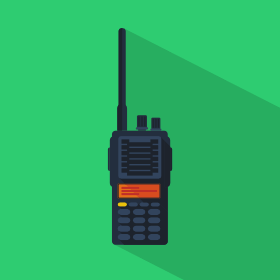
Chord names may look similar a scary jumble of letters and numbers at get-go. But once you learn how to read them, they'll go an incredibly useful tool.

Here's how:
- Chord names and symbols allow you to chop-chop play through a vocal
- They allow you to easily jot downward the chords to a song
- Chord names are a mutual language for musicians, making it much easier to communicate with band mates, jam buddies or other musician friends.
In brusk, these are all essential musicianship skills, all things that I focus on with this site!
And so, this commodity will teach you lot everything you demand to know!
How to use this guide?
So What's the best way to larn chord names and symbols?
The last thing I want to practise is overwhelm you lot with music theory you don't understand. Then, I've divided this guide into different sections, to tailor whatever stage you are in your journey of learning music.
The Showtime Stage: Learn a whole agglomeration of chords
The ''experience earlier theory' principle is a cornerstone of my music learning philosophy. In short, it means that theory makes a lot more sense when you lot tin connect information technology to actual music y'all've heard or played.
If you've never played a chord similar 'Am7' or Cmaj7' before, it will just be so dry and slow to acquire the theory backside them!
That ways the best way to start understanding chord names, is to only learn a whole agglomeration of chords. It sounds unproblematic and it is simple.
So section 1 explains how y'all can learn the most common and nigh useful chords on guitar.
The 2d Stage: Learn how to read chord names
Section 2 will help you employ all these chord names. I'll explain the nuts of how chord names are synthetic. Plus: how should y'all say those chord names out loud?
In section 3, yous'll learn about other means of writing these chords, using chord symbols. This department provides an overview of the different means the exact same chord can be written down using chord symbols similar circles, triangles and circles with lines through them.
By the cease of these two sections, you'll know how to say chord names out loud with confidence!
The Third Stage: Sympathise chord names
Section 4 discusses the logic behind chord names. What are those letters and numbers actually referring to? Now, this section does require some knowledge of music theory. In item, you lot need to know about sharps and flats, and you should sympathise what an interval is. (Sidenote: you can acquire all about this in Music Theory from Scratch.)
Department 1
You lot tin can split guitar chords into roughly three 'levels':
- Open Chords
- Barre Chords
- Other moveable chord shapes
Allow's take a quick wait at each of these.
1. Open Chords
The first guitar chords you'll e'er larn are open up chords. They're relatively easy to play, and however incredibly useful.
Open chords are the ones that you play in the offset iii frets of the guitar. They're called 'open' because these chords take 'open' strings in them. Those are strings that you practise selection (with your right hand), but don't fret (with your left manus).
You might've already learned open chords such equally Am, C, D, Em and Grand. But you can also play more advanced open up chords such as C7, Gmaj7 and Dm7.
Having a good grasp on these chords, is the foundation for whatever guitarist. And then if yous want to larn them, cheque out Guitar Chord Bootcamp: Open up Chords. Information technology will teach y'all the 24 most open chords, along with a couple dozens songs to practice them with!
2. Barre Chords
Barre chords allow you to play many, many chords that yous can't play as open chords. It makes information technology super easy to play even exotic sounding chords like "C#m7" or "Dbmaj7". That makes learning to play barre chords a really great way to become more familiar with many different chord names.
Now, this might audio a piffling complicated, simply it doesn't have to exist. One time y'all understand the power of moving shapes up and down the fretboard, you'll see that this is really pretty simple!
Basically, y'all need 2 things:
- Know the notes on the depression E string, and the A string.
- Know the most important barre chord shapes.
This is exactly what y'all'll larn in Guitar Chord Bootcamp: Barre and Beyond. By splitting up everything into bit-size chunks and practicing with dozens of songs, you'll store all the information 'in your fingertips', and then to speak.
Yous tin effort out the first lessons for complimentary.
"Honestly, after this piffling course I experience like I have learned more than nigh the guitar than I accept in over ten years."
- Eryk
3. Other moveable chord shapes
For open chords and barre chords (the first two categories in a higher place), I generally recommend you lot simply call up the shapes. But once you get to this stride, information technology makes a lot of sense to start learning nigh the theory of chord construction and how that relates to the fretboard. One time you understand that, yous can start to change the shapes you know to create heady, new chords.
This topic is as well big to cover in this commodity (though we'll get into the basics in department 4), but I'll give y'all the things you should learn.
- Starting time, larn intervals. Intervals are nothing more than the altitude between two notes. That distance tin can be large or pocket-size. Intervals are crucial: they are the foundation for music theory. They help united states sympathize everything from melodies and scales to chords and chord progressions.
- Next, you want to look into chord construction. You lot'll learn how any chord is made upwardly out of a root annotation (the lowest note in the chord), with certain intervals added to information technology. Understanding this, will allow y'all to see the logic behind chord shapes. Checking out the CAGED arrangement is as well helpful here.
All of this is covered in Music Theory From Scratch. It'll testify you lot how intervals piece of work on guitar, and how chord are constructed. You'll too run across all of this logic in activeness as you lot analyze dozens of songs in interactive quiz lessons. I might exist a little bit biased, but I think information technology's pretty awesome.
Naturally, the form is included in your membership if you're a StringKick All Access Member!
SECTION 2
This section volition to teach you lot how to say the chord names out loud. So if you come up across something like Abmaj7#11, you'll know to say 'A flat major seven precipitous eleven'. That means that I'm keeping music theory to an absolute minimum here. (If you lot're interested in the logic behind chord names, scroll down to section 4.)
Root note
A chord name tin can exist divided into two sections: a notation name (i.e. a alphabetic character) and everything else.

This note name indicates the lowest note of the chord, which nosotros call the root. This root note is e'er our starting point. This tin be any alphabetic character from A to G, which is sometimes be followed by one of 2 symbols: a sharp (#) or a flat (b):
And so these chords are called 'F sharp' and 'B flat'. You go the idea. Here give it a try:
Major and minor
Of course a chord is more than 1 note. So once we have our root annotation, nosotros showtime stacking other notes on top of this root note to build a chord with a sure mood. By choosing our 'ingredients' carefully, we tin can make chords that audio sweet or gloomy, tense or relaxed, happy or distressing. This collection of ingredients is known as the 'chord type'. Think of information technology every bit a recipe that tells musicians which notes they can add to a chord. The chord blazon is what I called 'everything else' above. Allow's update that:

These chord types fall into 2 large buckets: major and minor. You could roughly say that major chords sound happy and pocket-sized chords sound sad and gloomy.
To tell whether a chord is major or modest, simply check if the root note is immediately followed by an 'thou', which stands for 'pocket-size'. If there's an g, you lot're dealing with a minor chord. If at that place's not an m, y'all'll be dealing with a major chord in nigh cases. (There are a few exceptions that nosotros'll discuss later in this department.) Hither, endeavour it for yourself.
When you want to say the name out loud of a major chord, it'south not necessary to say 'major'. Y'all tin simply say the root annotation. So 'Db' is only 'D apartment'. C# is 'C abrupt'. However 'Bm' is 'B minor' and 'Abm' is 'A flat small-scale'. Give information technology a shot:
Numbers
Hope that went well! The adjacent thing you'll come up across, is a bunch of numbers similar 'vi', '7', 'b9' or '#11'. For example:
Pronouncing these numbers is simple: just read them out loud. Then the above chords are 'D small-scale seven', 'B seven' and 'Due east seven sharp 9'. Effort it:
E apartment seven flat nine flat thirteen
There is just one exception to this rule: 5. A five indicates that we're not dealing with a major or a minor chord, simply with a power chord. So 'G5' is a Thousand ability chord. D5 is a D power chord.
Number and letter combinations
There are three fix combinations of numbers and letters you might come across:
i. Sometimes a 7 will be preceded by the letters 'maj'. This indicates that we're dealing with a major seventh. Then Cmaj7 is a 'C major seven' chord and Fmaj7#11 is an 'F major seven precipitous eleven' chord.
2. A 9 might exist preceded with 'add'. And then you might come across a 'Cadd9' chord or a 'Ebmadd9' chord. These are pronounced 'C add ix' and 'E flat minor add nine'.
3. When a chord says 'sus2' or 'sus4' that means it'southward not major or modest: it's a suspended chord. Typically, nosotros simply use the shorthand names 'sus2' or 'sus4' instead of calling them 'suspended quaternary chord'. So Dsus4 is pronounced 'Dee sus four'.
Give information technology a shot:
Three more chord types
We're almost there, then hang on! There are iii more chord types that you'll come across, though they aren't as common as well-nigh of the chords we've discussed so far.
Half-macerated Chords
Example: Bm7b5
Using the knowledge you've learned and so far, you lot'd telephone call this is a 'B minor seven flat five' chord. And you'd be 100% correct. However, it'south more than commonly known as a 'B one-half-diminished chord'. Information technology's also commonly written using the ø-symbol, a circumvolve with a line through it. (For more on symbols, whorl downwardly to the department on chord symbols.)
Diminished Chords
Example: Cdim
You might've guessed it: if at that place's a half-macerated chord, there's too a diminished chord. They're hands recognised either through the messages 'dim' or a pocket-size circle (encounter chord symbols section). The above example is pronounced 'C macerated'.
Augmented Chords
Example: Caug
Lastly, there'southward augmented chord. Yous can recognise it by the messages 'aug' or a small plus (see side by side section) right next to the root notation. Pronounce it 'C augmented'.
Alright, let'southward put that to the test:
'C half-macerated' or 'C minor seven flat five'
'B flat one-half-diminished' or 'B flat pocket-size seven flat five'
Slash Chords
Finally, you lot might run across are chords like these:
These are so-called 'slash chords', simply because the chord names employ that big slash. So what does this slash mean? These chords practise not hateful that you have to play both chords at the same fourth dimension. The '/notation proper name' tells us that we should brand this note the lowest annotation in the chord, instead of the root notation. And then in the above examples, we're dealing with a C with a Chiliad in the bass, an A minor with a C in the bass and a Thousand seven with a B in the bass.
A minor with a Grand in the bass
D small-scale with an F in the bass
SECTION three
Upward until now, I've written all the chord names using characters that you lot tin can hands notice on your keyboard. Those are most oft used on the net.
But you can also use symbols such as ∆ (major seven) and Ø (one-half-macerated). Though you won't come beyond them a lot online (probably because they're a hurting to find on a keyboard), I love to employ these symbols considering they're simpler, shorter and cleaner. They're used all the fourth dimension in lead sheets, mostly for jazz music. Hither's an overview:
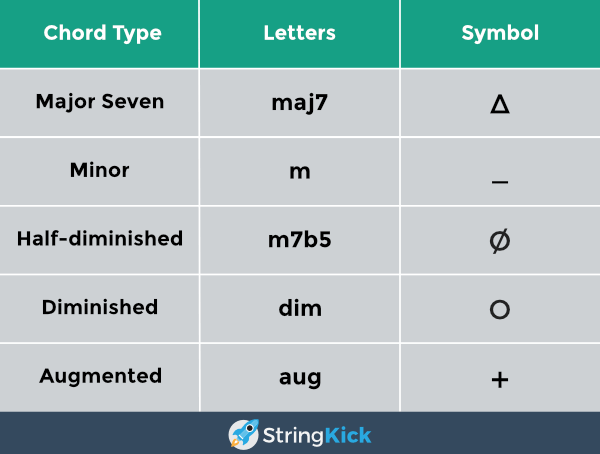
In that location are too some other options you might run into that I wouldn't recommend because they're disruptive. For example, using 'M7' to betoken major seven is a recipe for disaster because it'due south and so similar to 'm7' (minor seven). But, yous might run into these options, and then it's good to know near them.
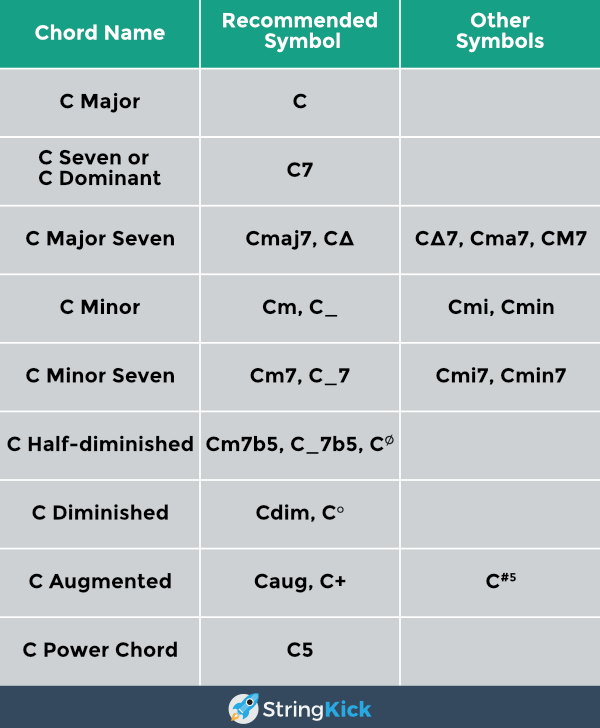
Department 4
So y'all know how to read chord names and you lot know how to play them. But what exercise all those letters and numbers hateful? What'due south the logic behind chord names?
In this section, we'll take a wait at the 'anatomy' of chord names: what components are they made up of and how do they fit together? Before you swoop in, y'all should know that this section requires some knowledge of music theory:
- You lot know about sharps and flats
- Yous understand what an interval is
If yous know those 2 things, this caption should brand sense.
If you are a StringKick All Access Member, you can of course have a grade to larn all most this! Check out Music Theory From Scratch to learn all about intervals and how to play them on guitar, and how chords are constructed (and much more!).
Chord Name Anatomy
A chord is a bunch of notes sounding together. If you'd walk over to a piano right now and press a random agglomeration of keys at the same time, that would be a chord. Of course, most chords we employ in music aren't made up of random notes, just are composed of carefully selected notes. We start with the lowest notation in the chord: the root notation. Nosotros then start stacking other notes on top of the root note to construct a chord with a sure mood. I similar to think of these stacked notes as ingredients: by choosing them carefully, nosotros can create chords with very specific 'flavours' or moods. We can make chords sound pitiful, happy, gloomy, sweet, tense, relaxed... In fact, nosotros take set 'recipes' for chords known equally 'chord types'.
That'south what a chord name really is: it's a recipe that tells the states musicians which notes we should add together to a chord in club to get a certain sound. This 'recipe' is fabricated up out of five possible components, which we'll tackle one by one. Here's the anatomy of a chord name:

- The Root
- The Chord Quality
- Sevenths or other added notes
- Extensions
- A specific bass note ('slash chords')
1. The Root
The first alphabetic character of the chord indicates the root note: that'southward the lowest annotation of the chord (with the exception of slash chords, as we'll see below). So even when you see something similar 'A7b9b13', you'll know that the everyman note of your chord will be an A.
Think of the root note as the starting betoken for every chord. While everything else in a chord name gives united states of america information about the 'chord type', the root name tells the states on which note to offset. The chord blazon is a blueprint for a building, and the root note tells the states where to construct that edifice.
Before you lot move on hither are some questions to exam yourself and make sure you understand everything then far.
2a. Chord Quality: Major and Minor
Once we have our root annotation, nosotros'll add together 2 notes to make a chord: a third and a fifth. Now, if you lot're familiar with intervals, y'all'll probably know that nosotros have ii kinds of thirds (major and modest) and 2 kinds of fifths (perfect and diminished). To construct our chord, we e'er choose one of each: one kind of tertiary and one kind of fifth. And which intervals we choose volition make up one's mind the chord quality, the second component of a chord name.
If we choose a minor third, our chord becomes a minor chord. To indicate this, we add together 'g' to chord proper name. Simply if we choose a major 3rd, our chord becomes a major chord. However, we don't add annihilation to a chord name to indicate this. A chord is ever major, unless indicated otherwise in the chord proper name.
A fifth is always perfect, unless our chord name indicates otherwise (which we'll get into in a second). So using these 'rules', you should be able to deduce what kind of thirds and fifths take been used in chords such equally Amaj7, Bm7 and C#. Let's give information technology a shot.
Because Dm7 has a small third in it, it's a minor chord.
Information technology has a perfect 5th in it. Unless indicated otherwise, the fifth is always perfect.
It has a major tertiary in it. Unless indicated otherwise (by an 'thou' and a few exceptions we'll discuss next), the 3rd is major.
It's a major chord, considering information technology has a major third in it.
It has a perfect fifth in it. Unless indicated otherwise, the 5th is always perfect.
2b. Chord Quality: 5 Exceptions
Nine out of ten chords volition consist of a major or pocket-size 3rd and a perfect fifth. But, of course there are exceptions, which we'll take a look at now. If you lot're offset getting into theory similar this, feel costless to skip these exceptions for at present by the way!
Chords with No 3rd: Power chords and Sus Chords
Power chords are unusual because they consist of just 2 notes: a root notation and a perfect fifth. They don't have a 3rd in them: not a minor third and non a major third. For that reason, power chords aren't major or minor. They're but a ability chord. Because they only consist of a root note and a perfect 5th, we write them by adding a 5 to the note name. For example: 'D5'.
Sus chords also don't have a third in them. Sus stands for 'suspended'. The reason why nosotros use the word 'suspended' is non worth getting into (it'due south related to counterpoint technique), so just read it equally 'the third has been replaced by a ....' So in the case of a sus2 chord, the third has been replaced by a major second. In a sus4 chord, the 3rd has been replaced by a perfect 4th. (Note: The fifth is always perfect in sus chords.)
Chords with a Diminished Fifth: Macerated and Half-Macerated Chords
You lot might've already wondered what happens when we don't add together a perfect 5th but a diminished fifth. At present, the macerated fifth is quite a rough sound, which is why but commonly utilise it in two chords: diminished chords and half-diminished chords. These chords both consist of 4 notes, three of which are exactly the aforementioned in both chords:
- A root annotation
- A small-scale third
- A macerated fifth
The last note nosotros add determines whether we're dealing with a macerated chord or a one-half-diminished chord. When nosotros add a minor seventh to our chord, we become a 'one-half-macerated' chord. We write it as 'Bm7b5' or Bø.
To become a diminished chord, we need to add together a so chosen 'macerated seventh'. Don't worry if you've never heard of a 'diminished 7th': information technology's nothing more the theoretically correct name for a major 6th interval. (It'southward not worth going into why this name is theoretically correct hither.) We write this chord either every bit Cdim or with a small circle: Co.
Chords with an augmented fifth: Augmented Chords
You lot'll probably come across this chord type the least, but this guide wouldn't exist complete without it. Sometimes a fifth volition exist 'augmented', i.due east. one fret/semi-tone higher than a perfect fifth. (In other words, the theoretically correct name for an interval that's but equally big as a minor 6th interval.) An augmented chord always has a major tertiary in it. To indicate a chord has an augmented fifth we either use 'aug' or a plus sign. So Caug or C+
Questions
Alright, permit'south put all that to the exam. This was a lot of information to process and remember, so don't hesitate to curl back up to find the answers.
It has a minor third in it.
An augmented chord has an augmented 5th in it.
An augmented chord always has a major 3rd in information technology.
Trick question: a Bb5 is a ability chord, which never has a 3rd in it.
It has a major second in it and a a perfect fifth. (So, no third!)
3. Added intervals: Sixths, Sevenths and Ninths
When we have a iii-notation major or small-scale chord, we can add together an actress note to information technology to give the chord some extra flavour and spice. There are four intervals that are regularly added to a three-notation major or minor chord: major sixths, minor sevenths, major sevenths and major ninths.
Major sixth
We often add a major 6th either to a minor or a major chord. We don't ofttimes add together a minor sixth to a three-note major or small-scale chord (simply because it doesn't sound all that compelling). To write information technology, we simply add together a vi to the chord. And so, hither are our options:

Some quick questions:
It has a major sixth in it.
It has a minor 3rd in it.
Major and Minor Sevenths
The ingredient we well-nigh often employ to add some grapheme to a chord is the 7th. To give a few examples:
There are 2 kinds of sevens: the major seven and the minor 7. We can add both of those either to a major chord or to a small chord. So that gets u.s. four options for when it comes to seventh chords:
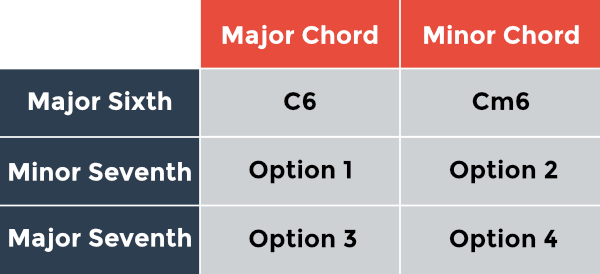
And so how do we indicate which type of interval we've added?
- When nosotros add '7' to the chord symbol, that means a minor seventh.
- When we add 'maj7' to the chord symbol, that ways a major seventh.
Knowing this, we can fill in our graph:
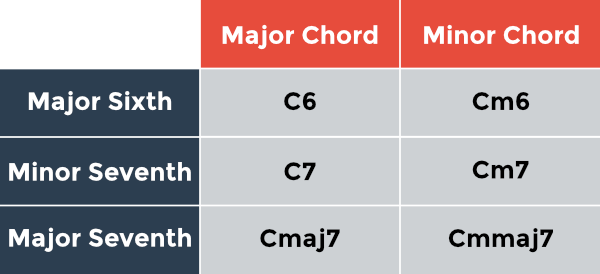
Make sense? Let's put that that knowledge to the test:
It has a pocket-sized 7th in it. A seventh is always small-scale unless indicated otherwise.
It's a minor chord, because information technology has a small-scale third in information technology.
It has a small-scale third in it.
It has a major seventh in it.
Major Ninth
The last annotation that is often added to a iii-note major or minor chord is the ninth. Like the sixth, there is but ane (common) pick: the major ninth. The only difference is that nosotros use a slight different 'label' to add this ingredient to a major or minor chord: 'add9'.
Hither are two examples:
Updating our chart:
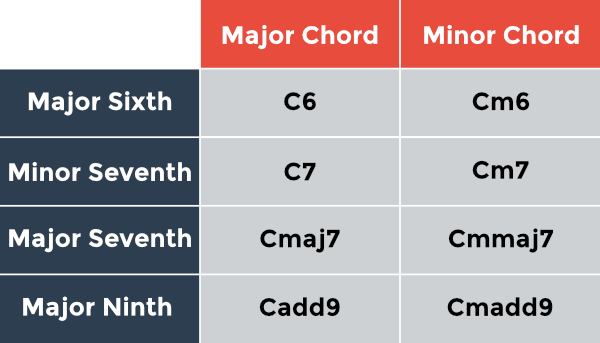
And some rapid-burn test questions:
Information technology has a major 9th in it.
4. Chord Extensions
Adding sixths, sevenths and ninths makes our chords sound a lot richer. But - of course - nosotros can create even more exotic sounds and chord flavours by adding more notes. These notes are what we telephone call 'extensions'. Extensions have names like:
- b9
- 9
- eleven
- #eleven
- b13
- xiii
Nosotros usually add extensions to a iv-note chord. This fourth note is ever a minor seventh, unless indicated otherwise. So for case, a D9, Am9 and Cm11 all have a pocket-sized 7th in information technology.
As yous might imagine, we tin use these extensions to create dozens of dissimilar chord types. So instead of listing all the options here, it makes more sense to sympathise how chord construction works so you can start making your own combinations to see what they sound similar. Here are just a few examples of chords with extensions:
Alright, allow'due south put that to the test!
A minor 3rd, perfect fifth, small 7th and major 9th.
A major tertiary, perfect fifth, major seventh and sharp eleventh.
A major third, a perfect 5th, small seventh and a flat 9th.
5. Slash Chords
Alright, then there'due south the very terminal component of a chord name. A slash with another annotation proper noun.
We call these 'slash chords', just because of the slash it uses (nope, no relation to Slash the guitarist).
So what does this slash with another note name mean? Retrieve the root note, that annotation that constructing a chord all starts with? The root notation is the offset letter of the alphabet we see in the chord symbols above. The one left of the slash. Usually the root note is the lowest note in the chord, but slash chords are the exception to this rule: the 2nd letter of the alphabet indicates a unlike note that should exist the everyman.
Maybe you're thinking, why would we ever exercise this? Well, because it sounds cool. Using a dissimilar annotation than the root in the bass creates a different kind of sound. It'southward besides used to brand chord progressions audio slightly 'smoother' because it often allows for a bass line that moves up or down in small steps. For example, compare the first and second lines in this chord progression. The only divergence is the G# in the bass in the 3rd chord. Requite it a listen.
Hear the difference? It's not that there's annihilation wrong with the start line, but the second line has a clearer direction. Here's another example:
The lowest note is an F#.
The ability of reading chord names and symbols
Chord names with all those letters, numbers and symbols may look intimidating at first glance. But hopefully this article has helped you to make sense of what's going on. Knowing how to read chord names and play them is an incredibly useful tool. It volition permit you to play new songs instantly just by looking at a bunch of chords. It'll too make it much easier to communicate with other musician considering it gives yous a common language.
If yous desire to learn more about chord names, playing guitar chords all over the neck and music theory (and more), learn more well-nigh condign a StringKick All Access Member! I'd love to have you lot on board and help you in your journey of growing equally a musician!
As ever, if yous have questions, feel gratuitous to email me at Merely (at) StringKick.com.
Source: https://www.stringkick.com/blog-lessons/chord-names-symbols/
0 Response to "What Does It Mean When You Are Playing Chords in the Left Hand on Keyboard When It Reads G Over F"
Postar um comentário